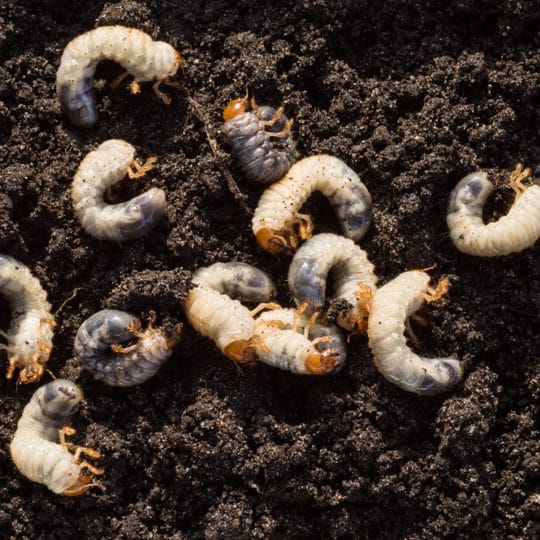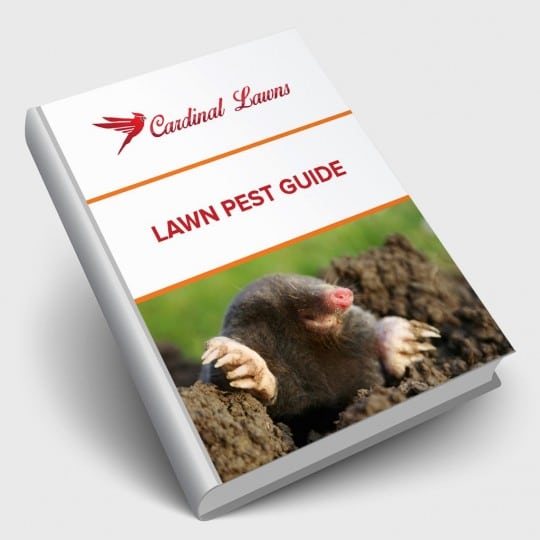7 Common Lawn Pests
How to Identify & Treat Any Infestation
Posted
May 18, 2023

Now that your grass, trees, and flowers are awake, so are certain pests. Here are some of the most common lawn pests you may find creeping around your yard and what to do about them.
Common Lawn Pests
Spring brings back lush green leaves, colorful flowers, and damaging insects. You may find more of these pests flying, tunneling, and laying eggs around your lawn this time of year. While they’re happier outside, it doesn’t mean they won’t find their way indoors if given the chance. Don’t give them the chance. Watch out for these common lawn pests and take action before they destroy your grass and move into your house.
- White Grubs. You may find these white wrinkly larvae curled up in your soil or underneath a patch of dead grass. They feed on grass roots during the early stages of life. Then they grow into different types of beetles and work on your flower and vegetable garden. If you notice patches of brown grass that’s easy to pull up, check underneath for the white grubs. Treat the area with a product specially formulated for grub control.
- Chinch Bugs. You may not see these tiny pests right away, but you’ll be able to see the damage they do to your yard. Chinch bugs feed on the surface of grass and leave a toxic saliva behind. Yellow patches of grass that don’t spring back to life when watered is one sign of infection. Apply a broad-spectrum insecticide as treatment.
- Billbug. Both young and mature billbugs have a way of damaging your lawn. The adults chew holes in the blades to lay their eggs. Once the larvae hatch, they eat their way out. You may not notice the damage until early summer once the cycle is complete. Not only will the grass turn brown, but there will also be a powdery substance left behind. If you’ve had issues before, you can always try to prevent the problem by applying a pesticide to target the adults in early spring. Another application in the fall kills any insect planning on spending the winter in your lawn.
- Ants. A few ants in your lawn has its benefits. Their tunnels help aerate and nurture the soil. However, too many tunnels can dry out the soil and produce unsightly mounds of dirt across your yard. These mounds also smother the grass to death. There are ant-specific pesticides that won’t harm your grass. To get rid of them more naturally, you can try mixing dish detergent, white vinegar and water to pour into the nest. This solution will damage your lawn, so it’s best for walkways around your home.
Pesky Worm Family
There are good worms and bad worms. You’ll find earthworms all over the place, especially after the rain. But these are the good guys that aerate and nurture the soil. The types of worms you don’t want to see may actually look like caterpillars. However, these pests won’t turn into beautiful butterflies. They will, however, dot your lawn with dead spots.
- Sod Webworm. You may not see these lawn caterpillars until late summer or fall, but if you’ve had an issue with them before, you can prepare yourself to do battle again. Their greenish-brown body with dark markings set them apart from their caterpillar cousins. Moths lay their eggs on the surface of your lawn, and once they hatch the webworms feed on grass blades creating dead patches. To treat, pick a product formulated for webworms and apply in the late afternoon or early evening when to they’re most active.
- Armyworm. Slightly larger than the sod webworm, this plump caterpillar-like creature is the larvae of the armyworm moth. It’s named for the fact that it invades your lawn in large numbers and destroys everything in its path. This is why you should act as soon as you see any signs, such as the pest or moth itself, egg clusters, or green fecal pellets in your grass. Treat your lawn with an insecticide that’s effective against armyworms.
- Cutworm. You’ll know this dark, smooth-bodied caterpillar is around if your grass blades are cut and dragged into underground burrows. Like most moths, they’re attracted to light. So, they’ll likely lay their eggs in the grass at night around well-lit yards. There are also specially-formulated insecticides that target this pest.
Professional Pest Control
Pests are typically drawn to poorly managed lawns. Tall grass and thick thatch make great hiding and nesting spots. However, even if you properly maintain your lawn, a few grubs or a colony of ants may take up residence around your home.
No matter what type of pest you have to deal with, a professional pest control company can help you treat the area and prevent their return. Contact Cardinal Lawns if you suspect pests are ravaging your lawn. Catch them in the early stages and you have a better chance of saving your property as a whole.

Download Your FREE Lawn Pest Guide
Pests become most prevalent during the heat and humidity of summer. Take some time to learn about the signs of infestations before any damage can be caused to your landscape. This handy guide will teach you how to spot common lawn pests and how to keep them from causing harm to you and your property.